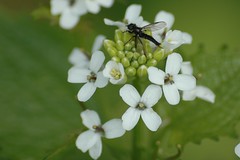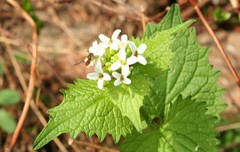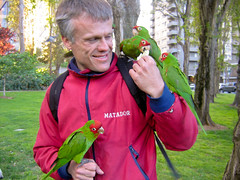 Not Green Enough
Not Green Enough
Originally uploaded by urtica.
Starbucks has a new environmental activism campaign - I think it is called "Planet Green." It seems to be centered around an internet game that aims to educate us about global warming and reducing our carbon footprints.
So what's the best way to get the word out about your company's new campaign to reduce the world's carbon footprint? By giving out free bookmarks, of course...free bookmarks with paper disks containing wildflower seeds that you can plant and presumably make the world a better place.
Sounds nice, doesn't it? Except someone needs to tell Starbucks that "wildflower" is not the beautiful, perfect embodiment of do-gooding they seem to think it is (I tried, but they have yet to respond). What species are these? Where are they native to? Are they potentially invasive? I could not find out the answers to these questions, and that is why I am concerned.
Don't get me wrong, I see good parts to the Planet Green campaign - the game itself was informative (though I got 300 points for visiting a Starbucks and not so many for visiting the mayor to talk about climate change). Starbucks is also running a reusable mug campaign to reduce the number of disposable cups - that's a good thing.
But this is an environmental campaign - isn't anyone looking at the big picture? Sowing seeds from who-knows-where is equated with doing environmental good? The campaign is done in partnership with Global Green USA. They're an environmental organization, aren't they supposed to know better?
Are these wildflower seeds from invasive plants? Probably not. So why am I making a big deal out of this? Because by not informing the public about just what is in those little white disks, Starbucks is ignoring the issue of invasive species and encouraging its customers to do the same.
I promise to report back here when I find out the rest of the story, if you promise to be responsible gardeners and not plant anything without finding out what it is and where it came from :-).
Update 4/6/07: As per an NPR report this morning, looks like we can add BP (British Petroleum) to the list of corporations that think being green=spreading seed. The NOTCOT blog has photo proof. I have contacted BP as well and will post updated here.
Update 4/13/07: One seedling has already sprouted, but still no word from Starbucks. I did get a short note from BP saying that they were forwarding my concerns to the manager of marketing at Helios House.
Update 4/23/07: A second email has been sent to Starbucks, still no response, and no response yet from BP. Plus thisnext posts about some super cute Starbucks gift card holders containing...you guessed it...strips of paper embedded with wildflower seeds. Is plain recycled paper just not cool enough anymore? Why not try some treefree stuff, or my personal favorite, Bluejean Bond?
Also, as John Peter points out in the comments below and on the Invasive Notes blog, The Leukemia & Lymphoma Society sends out packages of invasive forget-me-not seeds (Myosotis scorpioides) with their donation requests.






